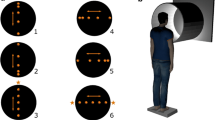Summary
When visual information is provided in addition to input from other sensory systems, normal body sway can be attenuated by about 50%. The essential visual cue is retinal target displacement, which increases as eye-target distance is reduced. As a result, both lateral and anterior/posterior (A-P) sway decrease as eye/target distance decreases. We have investigated the geometrical basis of lateral and fore-aft sway detection by vision, the latter provided by detection of change in disparity of the visual axis of both eyes and change in target size. Using known movement detection thresholds the largest possible distance for visual stabilization of posture can be calculated to be 34 m for lateral sway, and for fore-aft sway 1.50m for change in disparity and 3.20 m for change in size. Visual stimuli were designed to selectively stabilize fore-aft sway either by change in size or by change in disparity. The experiments revealed that the theoretical prediction overestimates the efficacy of visual stabilization of lateral sway and underestimates the efficacy of fore-aft sway stabilization. It is proposed that microoscillations of the eye increase the threshold for detection of retinal target displacements, leading to less efficient lateral sway stabilization than expected, and that the threshold for detection of self motion in the A-P direction is lower than the threshold for object motion detection used in the calculations, leading to more efficient stabilization of A-P sway.
Similar content being viewed by others
References
Barbur JL (1985) Speed discrimination and its relation to involuntary eye movements in human vision. Neurosci Lett 54: 7–12
Bles W, Kapteyn TS, Brandt T, Arnold F (1980) The mechanism of physiological height vertigo. II. Posturography. Acta Otolaryngol 89: 534–540
Bles W, Brandt T (1986) Disorders of posture and gait. Elsevier, Amsterdam
Brandt T, Dichgans J, Koenig E (1973) Differential effects of central versus peripheral vision on egocentric and exocentric motion perception. Exp Brain Res 16: 476–491
Brandt T, Arnold F, Bles W, Kapteyn TS (1980) The mechanism of physiological height vertigo. I. Theoretical approach and psychophysics. Acta Otolaryngol 89: 513–523
Collewijn H, Steinman RM, van der Steen J (1985) The performance of the smooth pursuit eye movement system during passive and self-generated stimulus motion. J Physiol 366: 19 p
Dichgans J, Körner F, Voigt K (1969) Vergleichende Skalierung des afferenten und efferenten Bewegungssehens beim Menschen: lineare Funktionen mit verschiedener Anstiegs steilheit. Psychol Forsch 32: 277–295
Dichgans J, Wist E, Diener HC, Brandt T (1975) The Aubert-Fleischl phenomenon: a temporal frequency effect on perceived velocity in afferent motion perception. Exp Brain Res 23: 529–533
Diener HC, Wist ER, Dichgans J, Brandt T (1976) The spatial frequency effect on perceived velocity. Vision Res 16: 169–176
Edwards AS (1946) Body sway and vision. J Exp Psychol 36: 526–536
Hlavacka F, Litvinenkova V (1973) First derivative of the stabilogram and postural control in visual feed-back conditions in man. Agressologie 14: 45–49
Kapteyn TS, Bles W, Brandt T, Wist ER (1979) Visual stabilization of posture: effect of light intensity and strobpscopic surround illumination. Agressologie 20: 191–192
Legge GE, Campell FW (1981) Displacement detection in human vision. Vision Res 21: 205–213
Okubo J, Watanabe I, Kotaka S, Murase H, Numano F (1980) The mechanism for equilibration and sway of the center of gravity in neurological diseases. Agressologie 21: 71–81
Paulus W, Straube A, Brandt (1984) Visual stabilization of posture: physiological stimulus characteristics and clinical aspects. Brain 107: 1143–1163
Regan D, Beverly KI (1979) Binocular and monocular stimuli for motion in depth: changing-disparity and changing-size feed the same motion in depth stage. Vision Res 19: 1331–1342
Regan D, Beverly KI (1983) Visual fields for frontal plane motion and for changing size. Vision Res 23: 673–676
Scobey RP, Johnson CA (1981) Displacement thresholds for unidirectional and oscillatory movement. Vision Res 21: 1297–1302
Stoffregen R A (1986) The role of optical velocity in the control of stance. Percept Psychophys 39: 355–360
Author information
Authors and Affiliations
Rights and permissions
About this article
Cite this article
Paulus, W., Straube, A., Krafczyk, S. et al. Differential effects of retinal target displacement, changing size and changing disparity in the control of anterior/posterior and lateral body sway. Exp Brain Res 78, 243–252 (1989). https://doi.org/10.1007/BF00228896
Received:
Accepted:
Issue Date:
DOI: https://doi.org/10.1007/BF00228896




